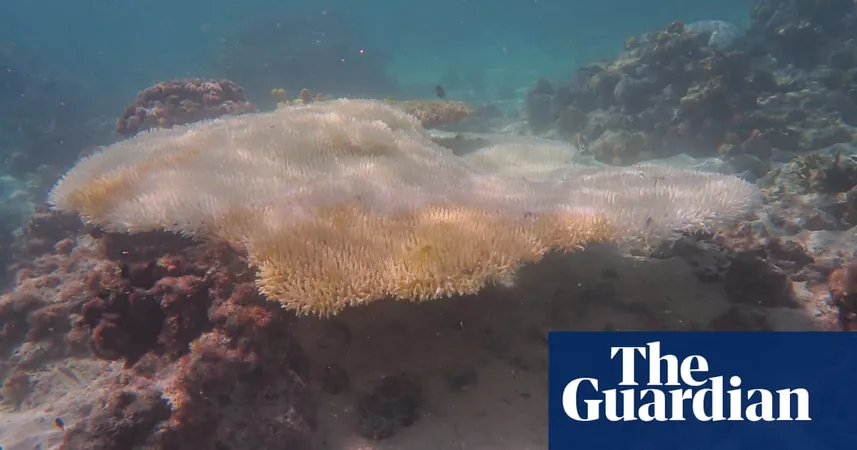
Catastrophic Coral Bleaching Strikes Great Barrier Reef: Scientists Sound Alarm
2025-01-21
Author: Jia
Introduction
In a shocking revelation, new research has uncovered that over 40% of the coral colonies monitored near One Tree Island in the Great Barrier Reef have perished, marking the most widespread coral bleaching event ever recorded in the area. Conducted amidst rising ocean temperatures, this study paints a distressing picture of our planet's marine health.
Research Findings
Researchers concentrated their efforts on 462 coral colonies, closely observing them as they succumbed to severe heat stress that began in early 2024. The findings were described by the team as “catastrophic,” with only 92 colonies managing to avoid bleaching completely. By the study's conclusion in July, 193 colonies were dead, and another 113 were still exhibiting troubling signs of bleaching.
Expert Opinions
Prof. Maria Byrne, a marine biologist from the University of Sydney and lead author of the study, expressed her heartbreak over the situation. “It is utterly devastating to witness the demise of these massive coral colonies,” she stated. Byrne, who has been studying One Tree Island for 35 years, lamented the ongoing effects of climate change and the urgency needed in addressing this crisis.
The Australian Institute of Marine Science (AIMS) corroborated these findings when they surveyed eight reefs in the Capricorn-Bunker sector, revealing a staggering 41% decline in hard coral cover—the most significant annual decrease since monitoring began in the mid-1980s. To exacerbate the crisis, some scientists in the northern section of the reef described encountering "graveyards of corals."
Monitoring Methods
The researchers utilized temperature loggers, video footage, and direct observations to monitor 12 different coral species throughout the year. They noted that while corals might potentially recover from mild bleaching if temperatures return to normal, the conditions observed at One Tree Reef indicated irreversible damage. “What we observed was not just alarming; it was catastrophic,” they concluded.
Specific Coral Concerns
The situation is particularly dire for a specific type of coral called Goniopora, known for forming robust, vibrant colonies. These corals not only exhibited signs of bleaching but also became victims of a virulent flesh-eating disease known as black band, further compounding their plight.
Researcher Reflections
Dr. Shawna Foo, a coral researcher from the University of Sydney, shared her frustrations after spending months observing the island's corals. “It was heartbreaking to see the abrupt transformation of a place I know so well. The colonies are increasingly unrecognizable, hidden under layers of algae, dead, or crumbling away," she explained.
Future Projections
As March approaches—the season typically characterized by peak heat stress in the reef—the Great Barrier Reef Marine Park Authority has issued a stark warning. Current temperatures in the marine park are reported to be up to 1.2°C above average, with projections indicating more widespread bleaching could occur as early as mid-February, particularly in regions north of Cooktown.
Call to Action
Richard Leck, head of oceans at WWF-Australia, cautioned against complacency, stating, “The data on last summer’s coral bleaching is still pending, but it’s evident that widespread mortality has occurred, particularly in the north. There is a real risk of back-to-back bleaching events, making the future of the reef hang in the balance.”
The Australian government faces pressure from UNESCO to provide a detailed report on the reef's conditions by next month. Leck emphasized the critical need for an accurate representation of reef health and called for renewed commitments to conservation efforts. “The reef’s World Heritage status is increasingly at risk, and we must act swiftly if we are to halt its decline.”
Conclusion
As experts voice their concerns, the world watches closely—will we take action in time to save the iconic Great Barrier Reef, or will this be yet another chapter in a tragic decline? The answer could determine the fate of countless marine species and the ecological balance of our oceans.




 Brasil (PT)
Brasil (PT)
 Canada (EN)
Canada (EN)
 Chile (ES)
Chile (ES)
 Česko (CS)
Česko (CS)
 대한민국 (KO)
대한민국 (KO)
 España (ES)
España (ES)
 France (FR)
France (FR)
 Hong Kong (EN)
Hong Kong (EN)
 Italia (IT)
Italia (IT)
 日本 (JA)
日本 (JA)
 Magyarország (HU)
Magyarország (HU)
 Norge (NO)
Norge (NO)
 Polska (PL)
Polska (PL)
 Schweiz (DE)
Schweiz (DE)
 Singapore (EN)
Singapore (EN)
 Sverige (SV)
Sverige (SV)
 Suomi (FI)
Suomi (FI)
 Türkiye (TR)
Türkiye (TR)
 الإمارات العربية المتحدة (AR)
الإمارات العربية المتحدة (AR)